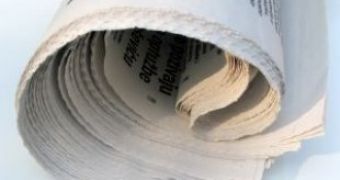A massive amount of gold and other precious metals is used every year to fabricate electronic consumer devices such as computers, television sets and mobile phones. It might not seem so obvious at first, but the landfill may literally be a gold mine. The real problem with recycling these metals is that the process is usually very complicated and expensive, requiring large amounts of chemical compounds that have damaging effects on the environment.
Japanese researchers now claim that they have developed a gold and other precious metal extraction method involving the use of treated paper, able to hold an amount of gold equivalent to its own weight. Old newsprint is first crushed and washed, then mixed with chlorine. Afterwards, the chlorine paper it treated with dimethylamine and formaldehyde, thus creating dimethylamine-paper gel which can then be turned into powder.
While testing the newly developed compound for its metal binding capabilities in a standard industrial liquid containing old metallic components in hydrochloric acid, the research team of the Saga University, Japan realized that it could absorb up to 90 percent of the gold, palladium and platinum concentrations, while more common metals such as copper, zinc or iron bonded to the paper in insignificant quantities.
Because of its amorphous nature, cellulose plays a crucial role in the structure of the gel as it allows chemicals to penetrate it easily, thus enabling it to absorb and hold roughly the same amount of metal as its own weight.
"And you can use the gel again after the metal [is removed]. [?] Our gel is prepared from inexpensive, renewable resources and it has high selectivity and capacity for precious metals. Those properties make it a wonderful adsorbent," says Chaitanya Raj Adhikari, a member of the team of researchers assisting the leader of the study Katsutoshi Inoue of the Saga University.
Although the results are rather impressive, other researchers point out a downside to the process: it takes about five hours for the paper to absorb the metals. "The adsorbing kinetics are very slow," said Jianmin Yu of the Kunming University of Science and Technology, China.

 14 DAY TRIAL //
14 DAY TRIAL //